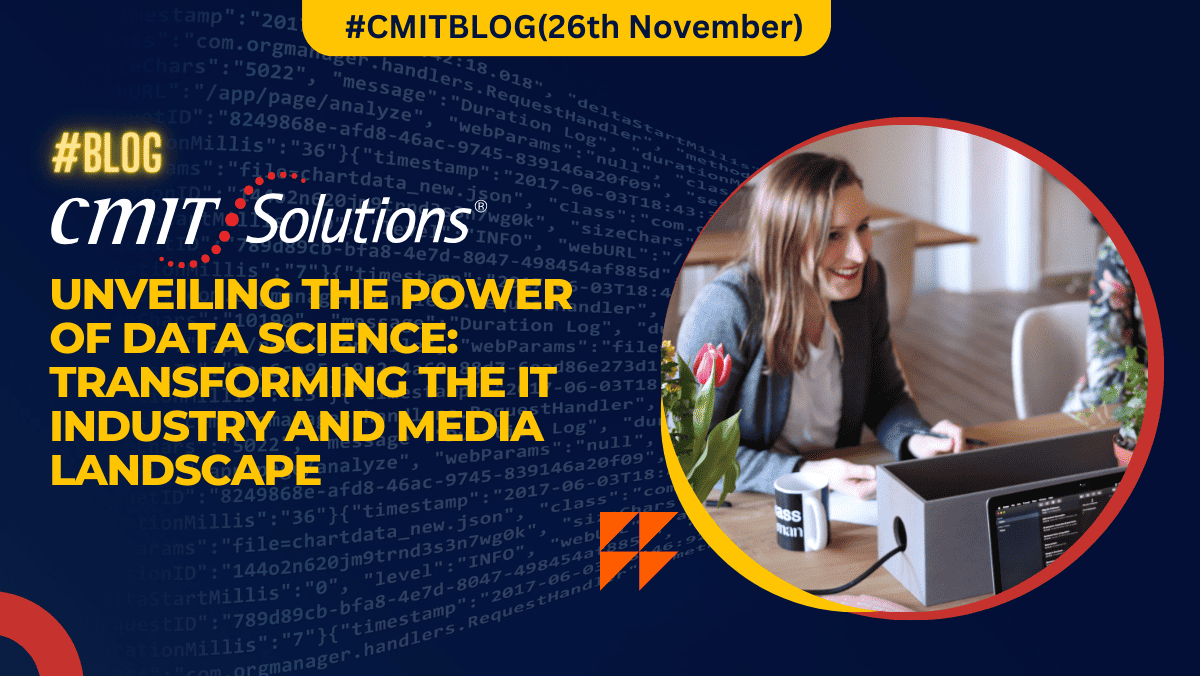Introduction
In the ever-evolving landscape of technology, the symbiotic relationship between data science and the IT industry is reshaping the way information is processed, analyzed, and utilized. Beyond its impact on technical operations, data science is also revolutionizing the media sector, influencing content creation, audience engagement, and the overall digital experience. In this blog post, we will delve into the profound integration of data science in the IT industry and its far-reaching implications on media-related practices.
1. Personalization Revolution: Tailoring Media Experiences
Data science enables personalized content recommendations, creating a tailored media experience for users. Algorithms analyze user behavior, preferences, and historical data to deliver content that aligns with individual tastes.
Example: Streaming services using recommendation algorithms to suggest movies or shows based on a user’s watch history and preferences.
2. Audience Insights for Content Creation
Media outlets leverage data science to gain deep insights into audience behavior, preferences, and engagement patterns. This data-driven approach informs content creation strategies, ensuring that produced content resonates with the target audience.
Example: News websites analyzing reader engagement to prioritize topics that generate high interest.
3. Real-Time Analytics for Decision-Making
Data science provides real-time analytics, empowering media professionals to make informed decisions on content strategy, advertising, and audience engagement. This agility is crucial in a fast-paced digital landscape.
Example: Social media platforms using real-time analytics to identify trending topics and adjust their content recommendations accordingly.
4. Optimizing Ad Campaigns with Predictive Modeling
Predictive modeling in data science enhances the effectiveness of advertising campaigns. Advertisers can analyze historical data to predict campaign performance, target audiences more effectively, and optimize ad placements for maximum impact.
Example: Digital advertising platforms using predictive modeling to estimate click-through rates and optimize ad delivery.
5. Enhanced User Engagement Through A/B Testing
Data science facilitates A/B testing, allowing IT and media professionals to experiment with different content formats, designs, or features. This iterative testing process optimizes user engagement and overall platform performance.
Example: News websites testing different headline formats to determine which ones lead to higher reader engagement.
6. Sentiment Analysis for Audience Feedback
Sentiment analysis, a facet of data science, is employed to gauge audience reactions and opinions. Media organizations can analyze audience sentiment to understand how content is received and make adjustments accordingly.
Example: Social media platforms using sentiment analysis to understand user reactions to specific posts or topics.
7. Data-Driven Storytelling: Merging Art and Science
Data science enhances storytelling in the media by incorporating data-driven insights into narratives. Journalists and content creators use data to add depth, context, and credibility to their stories.
Example: News articles integrating data visualizations to provide readers with a clearer understanding of complex issues.
8. Optimizing Content Delivery Networks (CDNs)
Data science plays a crucial role in optimizing content delivery networks, ensuring that media content is efficiently delivered to users. This improves website performance, reduces latency, and enhances the overall user experience.
Example: Streaming services optimizing CDNs to deliver high-quality video content with minimal buffering.
Advantages of Integrating Data Science in the IT Industry and Media:
1. Personalized User Experiences:
Data science enables the creation of personalized experiences for users, enhancing engagement and satisfaction.
2. Informed Content Creation:
Media organizations can make informed decisions about content creation by leveraging audience insights and preferences derived from data science analytics.
3. Real-Time Decision-Making:
Real-time analytics empower IT and media professionals to make agile decisions, responding promptly to changing trends and audience behavior.
4. Optimized Advertising Campaigns:
Predictive modeling enhances the effectiveness of advertising campaigns, leading to more targeted and impactful ad placements.
5. Improved User Engagement Through A/B Testing:
A/B testing allows for iterative improvements, optimizing user engagement by experimenting with different content formats and features.
6. Data-Driven Storytelling:
Data-driven storytelling adds depth and credibility to media narratives, providing audiences with a richer and more informed understanding of complex issues.
7. Enhanced Audience Feedback Analysis:
Sentiment analysis helps media organizations understand audience reactions, enabling them to tailor content to better resonate with their audience.
8. Efficient Content Delivery:
Data science optimizes Content Delivery Networks (CDNs), ensuring efficient and seamless delivery of media content, improving website performance and user experience.
Disadvantages and Challenges:
1. Risk of Biased Recommendations:
Personalized content recommendations based on historical data may lead to algorithmic biases, potentially limiting the diversity of content presented to users.
2. Data Privacy Concerns:
The extensive use of data in content personalization raises concerns about data privacy. Striking a balance between personalization and user privacy is crucial.
3. Technical Complexity:
Implementing and managing data science applications can be technically complex, requiring specialized skills and resources.
4. Overreliance on Data:
Overreliance on data-driven insights may neglect qualitative aspects, potentially overlooking nuanced aspects of content creation and audience engagement.
5. Potential for Algorithmic Bias:
Algorithms used in predictive modeling and recommendation systems may inadvertently perpetuate biases present in historical data, leading to unfair or discriminatory outcomes.
6. Resistance to Change:
Some stakeholders may resist the integration of data science, creating organizational challenges in implementing new technologies and methodologies.
7. Ethical Challenges in Data-Driven Storytelling:
Ethical considerations arise when incorporating data into storytelling, especially when dealing with sensitive topics or using data visualizations that may be misinterpreted.
8. Security Risks:
The reliance on data and connected systems increases the risk of cybersecurity threats, requiring robust security measures to protect sensitive information.
Conclusion
The integration of data science in the IT industry is not just a technical evolution; it’s a transformative force that reverberates throughout the media landscape. From personalized content recommendations to data-driven journalism, the collaboration between data science and the media industry is shaping the future of information delivery. As technology continues to advance, the synergy between data science and media will undoubtedly lead to more innovative, personalized, and engaging digital experiences for audiences worldwide.





